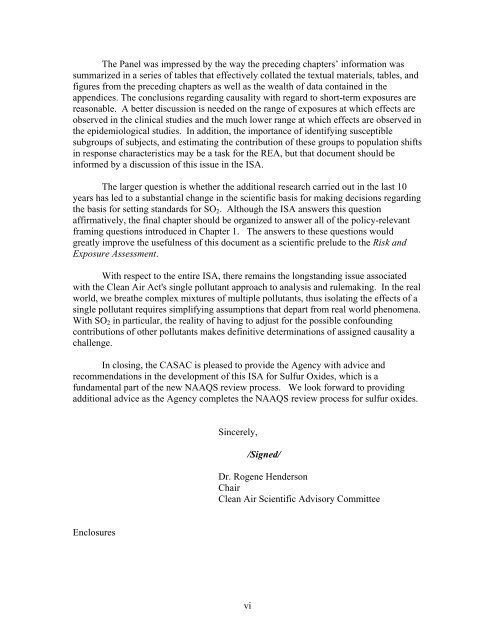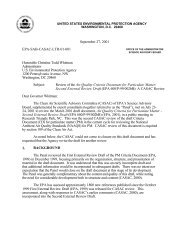(CASAC) Peer Review of EPA's Integrated Science Assessment
(CASAC) Peer Review of EPA's Integrated Science Assessment
(CASAC) Peer Review of EPA's Integrated Science Assessment
Create successful ePaper yourself
Turn your PDF publications into a flip-book with our unique Google optimized e-Paper software.
The Panel was impressed by the way the preceding chapters’ information wassummarized in a series <strong>of</strong> tables that effectively collated the textual materials, tables, andfigures from the preceding chapters as well as the wealth <strong>of</strong> data contained in theappendices. The conclusions regarding causality with regard to short-term exposures arereasonable. A better discussion is needed on the range <strong>of</strong> exposures at which effects areobserved in the clinical studies and the much lower range at which effects are observed inthe epidemiological studies. In addition, the importance <strong>of</strong> identifying susceptiblesubgroups <strong>of</strong> subjects, and estimating the contribution <strong>of</strong> these groups to population shiftsin response characteristics may be a task for the REA, but that document should beinformed by a discussion <strong>of</strong> this issue in the ISA.The larger question is whether the additional research carried out in the last 10years has led to a substantial change in the scientific basis for making decisions regardingthe basis for setting standards for SO 2 . Although the ISA answers this questionaffirmatively, the final chapter should be organized to answer all <strong>of</strong> the policy-relevantframing questions introduced in Chapter 1. The answers to these questions wouldgreatly improve the usefulness <strong>of</strong> this document as a scientific prelude to the Risk andExposure <strong>Assessment</strong>.With respect to the entire ISA, there remains the longstanding issue associatedwith the Clean Air Act's single pollutant approach to analysis and rulemaking. In the realworld, we breathe complex mixtures <strong>of</strong> multiple pollutants, thus isolating the effects <strong>of</strong> asingle pollutant requires simplifying assumptions that depart from real world phenomena.With SO 2 in particular, the reality <strong>of</strong> having to adjust for the possible confoundingcontributions <strong>of</strong> other pollutants makes definitive determinations <strong>of</strong> assigned causality achallenge.In closing, the <strong>CASAC</strong> is pleased to provide the Agency with advice andrecommendations in the development <strong>of</strong> this ISA for Sulfur Oxides, which is afundamental part <strong>of</strong> the new NAAQS review process. We look forward to providingadditional advice as the Agency completes the NAAQS review process for sulfur oxides.Sincerely,/Signed/Dr. Rogene HendersonChairClean Air Scientific Advisory CommitteeEnclosuresvi
















